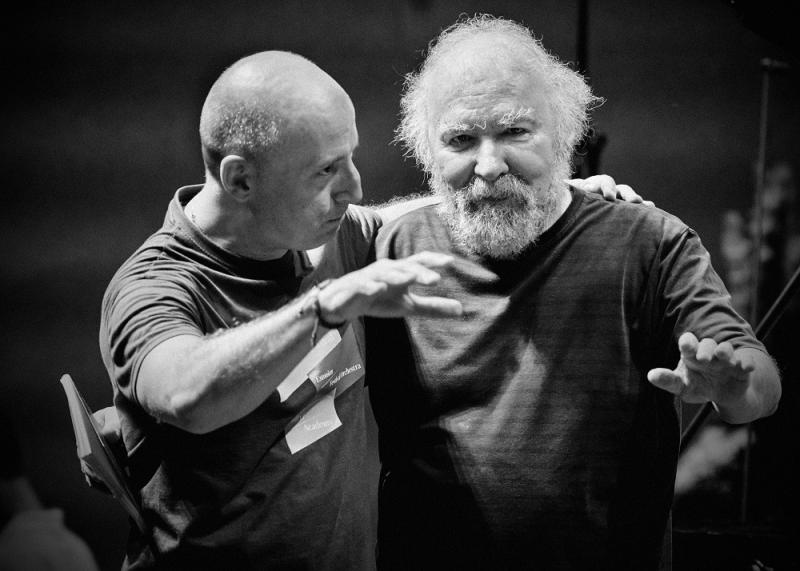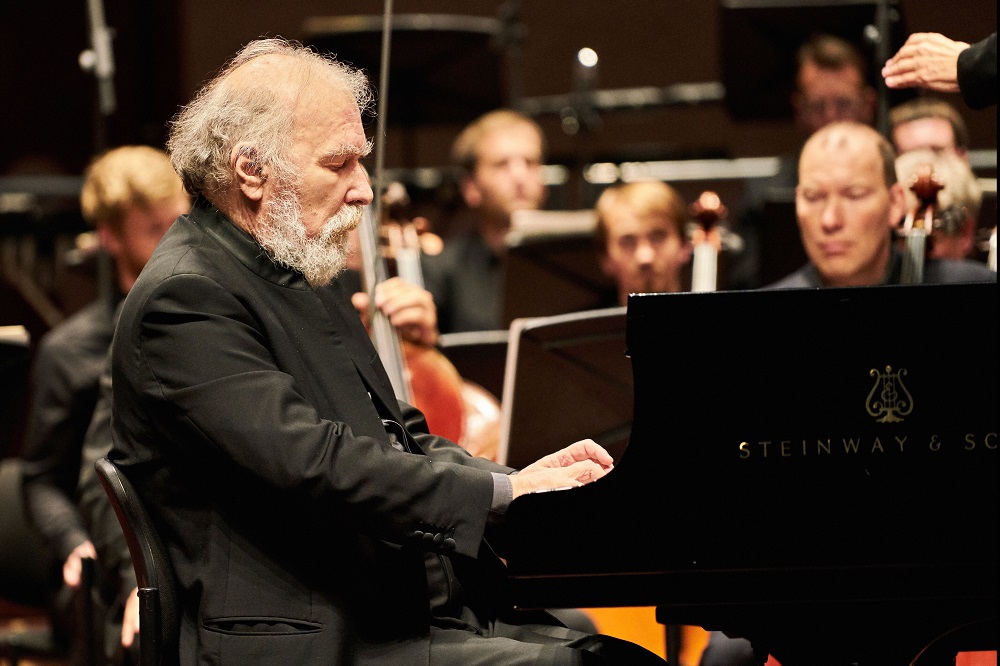Lupu, Philharmonia, Järvi, RFH review - concerto magical in parts, symphony stupendous | reviews, news & interviews
Lupu, Philharmonia, Järvi, RFH review - concerto magical in parts, symphony stupendous
Lupu, Philharmonia, Järvi, RFH review - concerto magical in parts, symphony stupendous
Delicacy from the legendary Romanian in Beethoven while Rachmaninov electrifies

Pianists most often cite Radu Lupu alongside Martha Argerich and Grigory Sokolov as the greatest. So it was hardly surprising to see so many top musicians in a packed audience, buzzing with expectation for the 73-year-old Romanian's most recent UK appearance with a conductor he respects, Paavo Järvi.
The subtlety is what many seek in Lupu's playing; there's a Schumann disc including Kinderszenen which is really heaven on earth. Now, though, it's not so much wrong notes – no-one minds those, up to a point, when listening to a legend – as missing ones in what should be perfect runs: pearls on a line, but with some gaps. The magic was often there, especially in the rapt mystery Beethoven introduces at the start of the first-movement development,and there was some fascinating left-hand accenting. But the composer's own, longer cadenza needs moments of fierceness, and so does Orpheus, in pleading with the Furies of the central drama. While there was nimble wit in the finale, including a lovely moment of rapport with conductor and orchestra just before the end, you sometimes felt Lupu, for all his watchfulness, was playing to some inner rhythm that didn't always correspond with reality.
Järvi, hawk-eyed for every slight waywardness, made sure that the Philharmonia matched the soloist for ghost voices, and one of the finest moments in the performance came near the beginning, violins hovering ever so slightly in the air on the top note of the second theme. Clearly this is a long-term partnership which works, but now there's more give from the orchestra than from the pianist. Lupu's encore (the pianist pictured below at the 2017 Pärnu Music Festival) was the inward poetry of Brahms's E flat Intermezzo, Op 117 No. 1; I was ready to be moved, but alongside the private world Lupu conjured the pulse seemed to falter. The rapturous ovation, you felt, was more for auld lang syne, but a little sympathetic imagination could find its way through to Lupu's special incandescence.  Beethoven's Coriolan Overture kickstarted a standard programme with Järvi stretching dramatic pauses between the lion's roars, but as the work stalked onwards, it became a bit of a distraction to find a cough planted in every one of the later silences. Rachmaninov's textures are more consistently lush in his biggest symphonic epic, covering the coughs, though to be fair the audience did seem to be perfectly still in the dying fall of the Adagio, violas fading to nothing before Järvi held the silence and plunged straight into the festival finale.
Beethoven's Coriolan Overture kickstarted a standard programme with Järvi stretching dramatic pauses between the lion's roars, but as the work stalked onwards, it became a bit of a distraction to find a cough planted in every one of the later silences. Rachmaninov's textures are more consistently lush in his biggest symphonic epic, covering the coughs, though to be fair the audience did seem to be perfectly still in the dying fall of the Adagio, violas fading to nothing before Järvi held the silence and plunged straight into the festival finale.
The Second Symphony is a work Järvi's recorded with the Cincinnati Symphony Orchestra; the Philharmonia also knows it well from Ashkenazy's several performances, and the present team had just been using it as a calling-card on tour. So one expected the polish. But how alive it all was in every phrase, Järvi's subtle rubato lending a special animation. Without the depth of sound and the humanity, it might have seemed a bit hard-pressed at times; but Järvi knows not to wallow in the many lush string melodies, and the one which comes on the heels of what was here an incredibly lively and focused main scherzo theme has never sounded more convincing in its place.
There was consistent richness, too, from the Philharmonia lower strings, a highly artistic timpanist, Antoine Siguré, and especially the horns, never better, revelatory in the low snarls that darken the canvas from time to time. Of course it depends on what Järvi the brilliant globetrotter wants to do in 2021 – he takes up a post as principal conductor of the Zurich Tonhalle Orchestra this autumn – but the Philharmonia is spoilt for choice of successor to Esa-Pekka Salonen between this regular visitor and principal guest conductors Jakub Hrůša and Santtu-Matias Rouvali. Exciting times, at least for our (threatened) musical world-within-world.
rating
Explore topics
Share this article
The future of Arts Journalism
You can stop theartsdesk.com closing!
We urgently need financing to survive. Our fundraising drive has thus far raised £49,000 but we need to reach £100,000 or we will be forced to close. Please contribute here: https://gofund.me/c3f6033d
And if you can forward this information to anyone who might assist, we’d be grateful.

Subscribe to theartsdesk.com
Thank you for continuing to read our work on theartsdesk.com. For unlimited access to every article in its entirety, including our archive of more than 15,000 pieces, we're asking for £5 per month or £40 per year. We feel it's a very good deal, and hope you do too.
To take a subscription now simply click here.
And if you're looking for that extra gift for a friend or family member, why not treat them to a theartsdesk.com gift subscription?
more Classical music
 Anja Mittermüller, Richard Fu, Wigmore Hall review - a glorious hall debut
The Austrian mezzo shines - at the age of 22
Anja Mittermüller, Richard Fu, Wigmore Hall review - a glorious hall debut
The Austrian mezzo shines - at the age of 22
 First Person: clarinettist Oliver Pashley on the new horizons of The Hermes Experiment's latest album
Compositions by members of this unusual quartet feature for the first time
First Person: clarinettist Oliver Pashley on the new horizons of The Hermes Experiment's latest album
Compositions by members of this unusual quartet feature for the first time
 Gesualdo Passione, Les Arts Florissants, Amala Dior Company, Barbican review - inspired collaboration excavates the music's humanity
At times it was like watching an anarchic religious procession
Gesualdo Passione, Les Arts Florissants, Amala Dior Company, Barbican review - inspired collaboration excavates the music's humanity
At times it was like watching an anarchic religious procession
 Classical CDs: Camels, concrete and cabaret
An influential American composer's 90th birthday box, plus British piano concertos and a father-and-son duo
Classical CDs: Camels, concrete and cabaret
An influential American composer's 90th birthday box, plus British piano concertos and a father-and-son duo
 Cockerham, Manchester Camerata, Sheen, Martin Harris Centre, Manchester review - re-enacting the dawn of modernism
Two UK premieres added to three miniatures from a seminal event of January 1914
Cockerham, Manchester Camerata, Sheen, Martin Harris Centre, Manchester review - re-enacting the dawn of modernism
Two UK premieres added to three miniatures from a seminal event of January 1914
 Kempf, Brno Philharmonic, Davies, Bridgewater Hall, Manchester review - European tradition meets American jazz
Bouncing Czechs enjoy their Gershwin and Brubeck alongside Janáček and Dvořák
Kempf, Brno Philharmonic, Davies, Bridgewater Hall, Manchester review - European tradition meets American jazz
Bouncing Czechs enjoy their Gershwin and Brubeck alongside Janáček and Dvořák
 Solomon, OAE, Butt, QEH review - daft Biblical whitewashing with great choruses
Even a top soprano and mezzo can’t make this Handel paean wholly convincing
Solomon, OAE, Butt, QEH review - daft Biblical whitewashing with great choruses
Even a top soprano and mezzo can’t make this Handel paean wholly convincing
 Two-Piano Gala, Kings Place review - shining constellations
London Piano Festival curators and illustrious friends entertain and enlighten
Two-Piano Gala, Kings Place review - shining constellations
London Piano Festival curators and illustrious friends entertain and enlighten
 Echo Vocal Ensemble, Latto, Union Chapel review - eclectic choral programme garlanded with dance
Beautiful singing at the heart of an imaginative and stylistically varied concert
Echo Vocal Ensemble, Latto, Union Chapel review - eclectic choral programme garlanded with dance
Beautiful singing at the heart of an imaginative and stylistically varied concert
 Scott, Irish Baroque Orchestra, Whelan, RIAM, Dublin review - towards a Mozart masterpiece
Characteristic joy and enlightenment from this team, but a valveless horn brings problems
Scott, Irish Baroque Orchestra, Whelan, RIAM, Dublin review - towards a Mozart masterpiece
Characteristic joy and enlightenment from this team, but a valveless horn brings problems
 Classical CDs: Voice flutes, flugelhorns and froth
Baroque sonatas, English orchestral music and an emotionally-charged vocal recital
Classical CDs: Voice flutes, flugelhorns and froth
Baroque sonatas, English orchestral music and an emotionally-charged vocal recital

Add comment